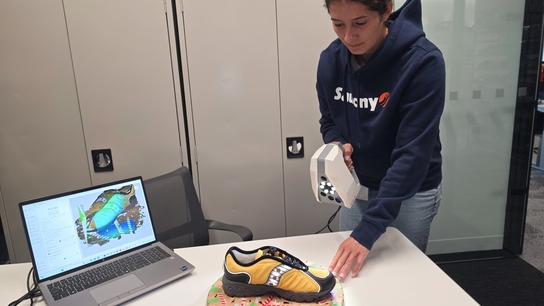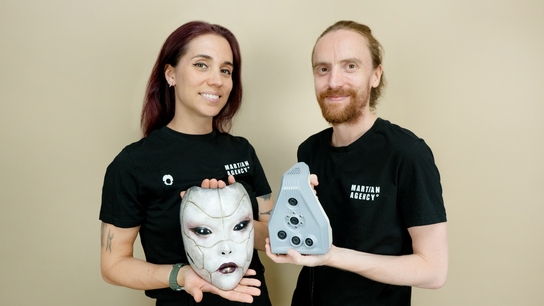From temple to tech: Artec Eva gets instrumental in 3D transformation of Japan’s sacred Chichibu Shrine
Challenge: A vibrantly colored masterpiece sculpted by Edo-period artisan Hidari Jingorō, the ‘Connecting Dragon’ stands at the heart of the shrine but continues to face the challenges of weather-induced fading over time. To address this, the Chichibu Shrine needed a way to capture both elaborate shapes and rich hues for the faithful 3D reproduction of the sculpture.
Solution: Artec Eva, Artec Studio, Mimaki Engineering 3D printer
Result: Artec Eva scans served as a basis for the faithful digital reproduction of the sculpture in every magnificent shade. Eventually, the ‘Connecting Dragon’ was recreated using a state-of-the-art full-color 3D printer, marking a significant leap in preservation of Japanese cultural heritage.
Why Artec: Artec 3D solutions are the top choice for digitizing complex art patterns due to their capability to quickly capture the intricacies while preserving the vivid colors. High-resolution scanning and non-invasive approach guaranteed by Artec Eva helped render the timeless beauty of the Chichibu Shrine while keeping it accessible to admire and completely safe.

The Chichibu shrine building is designated as a Tangible Cultural Heritage of Saitama Prefecture as an architectural landmark of the early Edo period.
Breathing life into Edo-period heritage: the role of 3D technology at Chichibu Shrine
The resplendent traditional Japanese architecture stands as a testament to the exquisite artistry of a bygone era, and it would be heartbreaking to witness its gradual fading into the annals of time. Resonating with this, the idea of using 3D technology to digitize museum exhibits and cultural artifacts is gaining momentum. In addition to capturing objects like pottery, paintings, and sculptures, non-invasive rendering of architectural structures and their decorations with Artec 3D scanners has opened up significant possibilities for preservation of cultural heritage.
The advancement of full-color 3D printing, which can accurately reproduce not only fine geometry but also colors – based on high-quality textured scans – has made it possible to procure exhibit materials and architectural components faster and more cost-effectively. One exemplary case is the recent experience at the Japanese Chichibu Shrine.
“The building of the shrine was donated by Ieyasu Tokugawa in 1592,” said the 35th hereditary Chief Priest of the Shrine. “It is labeled a Tangible Cultural Property of Saitama Prefecture because it retains the architectural style of the early Edo period well. Chichibu Shrine has escaped weathering and has become one of the most valuable shrines in Japan, carrying on an age-old tradition. As part of our efforts to preserve this tradition and culture, we have decided to digitize the shrine this time.”
Chichibu Shrine, located in the heart of Chichibu City, Saitama Prefecture, has started a monumental project during its 2,100th-anniversary festivities, spanning five years. The focus? A meticulous renovation of its main hall, including the restoration of brightly-colored sculptures, notably the ‘Connecting Dragon’ by the Edo-period master Hidari Jingorō, renowned for his work on the ‘Sleeping Cat’ at Nikkō Tōshō-gū.

The renovated ‘Connecting Dragon’ by the Edo-period master Hidari Jingorō
This three-dimensional cultural gem, proudly displayed at the shrine’s core, faces the elements daily, its vivid hues gradually fading over time, which leads to periodic restoration. However, the creation of exhibition models to replicate this sculptural piece seemed somewhat of a Herculean task. Fortunately, the cutting-edge Artec 3D scanning technology came to the rescue, enabling the true-to-life recreation of the ‘Connecting Dragon’ and preserving Edo-era craftsmanship.
Behind the scenes: meticulous scanning of the ‘Connecting Dragon’ with Artec Eva
Yosuke Hara of Hara Seisakusho, who led the 3D scanning efforts, explained, “By restoring and dedicating the skills of Edo-era master craftsmen using high-precision full-color 3D scanning technology and a high-precision full-color industrial 3D printer, we are preserving cultural heritage as valuable and enduring documentation for future generations.”
Choosing the right device wasn’t left to chance, either. Hara Seisakusho relied on Datadesign, the company that has been a pacesetter in consulting and R&D for 3D scanning, printing, and modeling technologies across Japan since 1989. Seasoned Artec Ambassadors, Datadesign team went all out to suggest a tried and tested solution. The lightweight Artec Eva, renowned for its speed and versatility, has been a massive hit in heritage preservation applications. Its ability to quickly capture medium-sized objects of bright color has made it a favored choice for digitizing cultural artifacts, architectural structures, and artworks.

Capturing ultra-precise 3D data off the ‘Connecting Dragon’
Using a handheld Artec Eva, the team painstakingly approached and scanned every nook and cranny, ensuring every tiny detail was carefully captured. Capturing the towering ‘Connecting Dragon,’ perched precariously atop a ladder, was no small achievement, and Artec Eva’s portability and speed played a vital part in safe scanning.
‘Connecting Dragon’ is a multi-dimensional piece, which prompted data recording from all angles. Precise geometry data acquisition required getting as close as 30 centimeters to the sculpture, with ladders, tripods, and steady hands to assist. All this hard work resulted in a 3D model brimming with minuscule details, from scales to whiskers, alongside a vivid array of colors, a testament to the capabilities of modern full-color 3D devices.
“The 3D modeling allows us to see the sculptures from angles that were not previously possible,” the Chief Priest added. “I think this is valuable for people studying sculpture. We also used the 3D model to create an ema (votive tablet), which gave more people the opportunity to learn more about ‘Tsunagi no Ryu’ (the tethered dragons).”
A digital renaissance for culture and artistry preservation in the 3D era
With reviving ‘Connecting Dragon,’ Mimaki Engineering’s full-color industrial 3D printer, renowned for its water-soluble support materials, came in handy. This innovative technology facilitated the removal of support materials by dissolving them in water during excavation, ensuring the faithful recreation of highly intricate shapes.

Restoring the majestic ‘Connecting Dragon’ perched high above the Shrine
“We believe that the use of 3D technology will open up a variety of possibilities that have never existed before,” the Chief Priest concluded. “For example, it will be possible to scan cultural properties and use the 3D models to create miniature cultural properties that can be displayed in museums and art galleries. What used to be done by hand by craftsmen can now be done in a shorter period of time at a lower cost by using digital technology. In addition, by creating 3D models, we will be able to see buildings and cultural heritage from angles that have not been seen before, which will lead to new discoveries.”

The bright hues of the ‘Connecting Dragon’ as a symbol of the Shrine
3D innovation combines the soaring precision of 3D scanning with the efficiency of industrial 3D printing, offering a blend of opportunities in the rapidly evolving landscape of heritage preservation. However, there’s one even more profound aspect to this.
“As a chief priest, I am responsible for the culture and traditions of Chichibu, as well as the safety and peace of the local people. We need to not only make the area a tourist attraction but also to pass on the culture and traditions that have been handed down from our ancestors to the next generation. We have decided to use a 3D scanner in the hope of preserving these traditions through digitization,” the Chief Priest said.
This goes entirely in line with what Artec 3D technology has been used for – making sure that the rich tapestry of history, art, and culture is faithfully preserved for generations to come.
Scanners behind the story
Try out the world's leading handheld 3D scanners.





